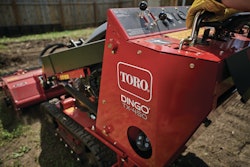Navistar unveiled its 2010 MaxxForce 13-liter advanced Exhausted Gas Recirculation (EGR) engine on Feb. 3 at the World of Concrete in Las Vegas.
Through the use advanced fuel injection, air management, electronic controls, and proprietary combustion technology, the engine meets U.S. Environmental Protection Agency 2010 emissions standard for on-highway diesel engines.
“We’re on track to meet 2010 emissions with the Maxxforce with advanced EGR technology,” Jim Hebe, senior vice president for International’s North American sales operations, told reporters. Hebe touted EGR as superior technology over Selective Catalytic Reduction (SCR) technologies, which the company’s competitors are using.
“EGR is the best technology,” Hebe said. “Our competitors talk about fuel economy with SCR. But with EGR, there is no lost time for filling up your urea tank, and you don’t tie up sapce on your frame rail with equipment. Our customers say space is critical.”
Hebe also questioned the availability of urea, if it so, whether it would be toxic for the operator to use.”If you’re off highway, will local filling stations offer urea? And if you’re a construction equipment operator or a concrete operator in the United States, what do you do when urea decomposes?”
Urea begins to decompose at 80 degrees Fahrenheit. At 120 degrees Fahrenheit, the urea becomes toxic and at 12 degrees Fahrenheit it freezes.
Hebe says the company’s focus on EGR is part of the company’s complete reorientation toward severe service and vocational applications. “We have 18 to 20 targeted segments, and we have a clear strategy for each one,” Hebe said.
Navistar says that many of the OEMs adopting the SCR strategy point to the success in meeting Europe’s emissions standard, which aren’t as stringent as U.S. standards. But Ramin Younessi, group vice president, truck and engine product development for the company, downplays the potential long-term use of SCR.
“At least two European engine manufacturers are moving toward a non-SCR solution to meet Europe’s next emissions hurdle,” Younessi says in a written statement distributed at the press conference. “That should raise some doubts about the long-term viability of SCR.”
Hebe adds that the company believes “the accountability for emissions compliance should rest on the manufacturer, not on the actions of the driver,the reliability of very complex technologies or the impact of climatic conditions.
“The development and testing of our EGR solution for 2010 is in advanced stages, and we are confident that our engines will deliver the performance, reliability, and low operating costs our customers demand,” Hebe said.
He said the company’s Paystar is 2010 compliant “as it sits and we’re d*mn proud of it.”
But during a question and answer period, a reporter asked whether touting the company’s MaxxForce engine as being 2010 compliant was “being disingenuous.”
The engine actually runs at 0.5 grams of NOx emissions, but with use of U.S. EPA-allowed credits, the engine is 2010 compliant, with NOx emissions of 0.2 grams.
Hebe made it clear that the company does in fact meet emissions requirements, and that the EPA encourages the use of credits so companies will create cleaner-running engines prior to actual emissions enforcement.
“The 2010 emissions requirements say we can run at 0.5 grams of NOx with credits and clean it up to 0.2 grams of NOx,” Hebe said. “So we are in compliance. If we’re doing what the EPA wants us to do, why is that so bad?”
Hebe added that the company “is ready to grow, is ready for 2010 across the board,” and has “only begun what we think will be continued success. We are well-positioned to take advantage of the exit of Sterling.”









